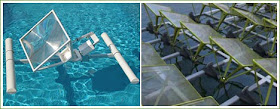There’s a lot of surface area on this planet for
solar panels. The ocean’s are a vast area to utilize this solar
technology. But, the weather can make the installation and use of
floating solar arrays difficult. That’s not the case with LSAs (Liquid
Solar Arrays) by Sunengy Pty LTD.
The floating solar power units, called Liquid Solar Arrays (L.S.A), use
concentrated photovoltaic technology where a lenses direct the light
onto solar cells and move throughout the day to follow the sun.
The company says the advantage to floating a solar power plant is that
it erases the need for expensive structures to protect it from inclement
weather and high winds — when rough weather comes along, the lenses
just submerge. Floating on water, whether it be the ocean, a lake or a
tiny pond, also keeps the solar cells cool, which increases their
efficiency and lifespan.
“The LSA system is based on floating solar collectors made mostly of
plastic. Each has a very small area of silicon photovoltaic cells at the
water surface with a large, thin plastic focusing lens rotating slowly
above to track the sun. The water cools the silicon cells and in bad
weather the lens is protected by rotating it fully under the water to
avoid damage in high winds. ”
What is liquid solar array technology: In this
technology, lens and photo voltaic cells are made to float on the
water. These absorb solar energy during the day. There is no need to
undertake any construction in water as these are made to float with the
new technology. This can withstand all adverse weather conditions.
This new technology will convert the dam into a big battery. Solar
energy can be stored without any cost. Liquid Solar Array technology
provides an opportunity to maintain water resources more effectively.
Special features of LSA: LSA technology is cheap and it
can even withstand cyclones. Land is not needed for establishing this
plant and so there will not be any problems for procuring the land. In
India, there is 30 thousand square kilometers of water area and even if
1% of it is utilized for this technology, electricity that is equal to
the electricity produced by 15 big thermal electricity plants can be
produced.



Floating solar power systems are wonderful ideas. And it’s very important to maintain effectively same direction and position on the water for floating solar plants. Because directional change of solar panels reduces electricity production. So floating solar plants also need the directional control mooring systems for their parked positions. Azimuth and position change of floating solar plants caused by wind, waves and external forces. Restoring Force Strengthened Mooring System for floating solar plants has been created in South Korea. This Mooring System generates Restoring Force immediately when floating solar plants are being rotated or moved on the water.
ReplyDeleteIn addition, you have to reduce vibration to install floating solar plants. Because, it can make micro-cracks to floating solar panels and the durability problem of floating solar plants. The risk of power loss in PV modules due to micro cracks is increasing. Vibrations caused by wind, waves and external forces. New Type Floating Body Stabilizer has been created in South Korea. The Floating Body Stabilizers generate drag force immediately when floating solar plants are being rolled, pitched and yawed on the water. Recently, Restoring Force Strengthened Mooring Systems and Floating Body Stabilizers have been used for floating solar plants in South Korea. You can see them in Ochang Dam natural reservoir, South Korea. I N I WORLD
I got here much interesting stuff. The post is great! Thanks for sharing it! Coronavirus cleaning services Brookhaven
ReplyDelete